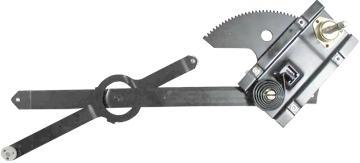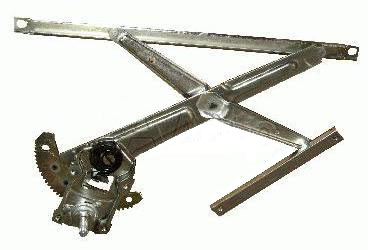What Does a Window Regulator Do?
A window regulator is a mechanical device that holds the window in place and allows it to move up and down. In other words, it “regulates” the movement of the window. Window regulators can be mechanical or electrical and sit behind the door panel. They are usually held in place to the door by a few screws or bolts, and on most vehicles can be replaced by novice do-it yourselfers.
The Different Types of Window Regulators
Mechanical/Manual Window Regulators

Mechanical or manual window regulators were common in vehicles until the end of the 20th century, when power operated windows became the norm. They are operated by a crank that is turned manually, which shrinks or expands the device and lowers or raises the window.
Electrical Window Regulators
Electrical window regulators are found on most new vehicles, and this has been the norm since the early 21st century. Electrical regulators are operated by a button on the door panel or master control switch. The window motor is connected to wiring in the switch, which then powers the lifting or lowering of the windows.
Scissor-Type Window Regulators

The scissor-type window regulator gets its name from its shape and design, which is simple and has existed for many years. As it expands, the window goes up. When it contracts, the window glass rolls down.
The wheels on the ends of them can wear out over time and break off. This will tilt your door glass sideways, and the window may eventually fall down into the door. They can also wear out at the center of the scissor mechanism, which can make them noisy, loose, and unpredictable.
Cable-Type Window Regulators

The cable-type window regulator is a modern design that is used in a variety of vehicles. This type of window regulator takes up less space inside the door, which allows for more room for additional safety devices.
Unfortunately no window regulators are immune to breakage. With a more complicated design than the scissor-type, these window regulators have more opportunity to break. The pulleys and cables in these regulators can wear out and snap. When that happens, the glass almost always falls inside the door, leaving your interior open to nature's elements.

How to Extend the Life of a Window Regulator
As with any mechanical item, there are some ways to extend the life of a window regulator as it ages with use and time. These are also areas to double and triple-check when you install a new replacement window regulator or motor.
o Lubricate every moving part of the window regulator with spray grease. Spray grease comes in a can and can be purchased at any local hardware store.
o Check the exterior window sweeps or window felts for damage. This will prevent rain, snow, ice, dirt, and debris from leaking into the door.
o Lubricate the window tracks at the front and rear of your side glass. Smooth moving glass is essential to long window regulator life. If the glass binds up, the window lifting mechanism will undoubtedly break shortly after.
This may go without saying, but don't force the window up or down by hand. If either of those is necessary, the window regulator is likely already damaged.
Replace a Window Regulator Yourself
Check out this video below and learn the steps for replacing a window regulator yourself, or find a video specific to your year, make, and model in our how-to video library.
